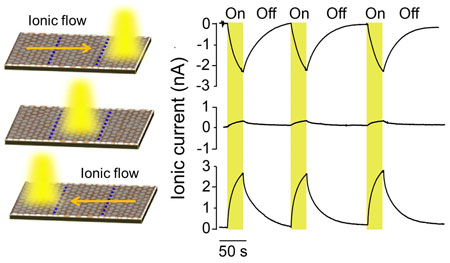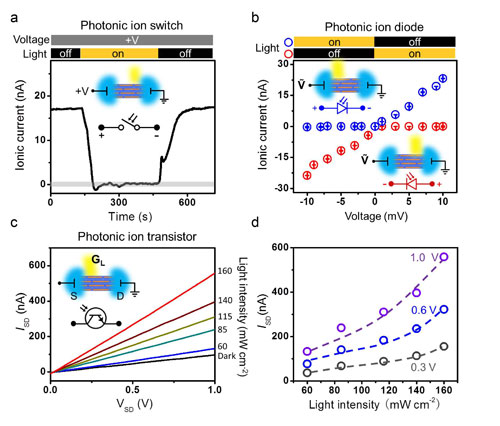| Mar 18, 2019 | |
Light-induced active ion transport in graphene oxide membranes |
|
| (Nanowerk Spotlight) Nanofluidic channels feature a unique unipolar ionic transport when properly designed and constructed. Recent research in nanofluidics has adopted reconstructed layered two-dimensional (2D) sheets – such as graphene oxide or clay – as a promising material platform for nanofluidics. These membranes contain a high volume fraction of interconnected 2D nanochannels. | |
| Compared to other materials used for nanofluidic devices, such as anodized aluminum oxide membrane, block copolymer membrane and nanofluidic crystals, a unique feature of layered membranes is that the channels are horizontally aligned and the channel height (i.e., the spacing between the layers), which is responsible for confinement of the electrolyte, remains uniform throughout the entire thin film. | |
| "However, mass and charge transport in existing membrane materials follows their concentration gradient," Wei Guo, a professor at the Technical Institute of Physics and Chemistry, Chinese Academy of Sciences, Beijing, tells Nanowerk. "Attaining anti-gradient transport as effective as natural counterparts remains a great challenge in fully abiotic nanosystems." | |
| In new work led by Guo, reported in Nature Communications ("Photo-induced ultrafast active ion transport through graphene oxide (GO) membranes"), the researchers demonstrate a coupled photon-electron-ion transport phenomenon through graphene oxide membranes. | |
| It shows a straightforward way on how to power the transport in 2D layered materials using the energy of light. | |
| "Using the energy of light, cations are able to move thermodynamically uphill over a broad range of concentrations, at rates orders of magnitude faster than that via simple diffusion," Guo explains. "Based on this mechanism, we developed photonic ion switches, photonic ion diodes, and photonic ion transistors as the fundamental elements for active ion sieving and artificial photosynthesis on synthetic nanofluidic circuits." | |
| This is the first discovery of photo-induced active (anti-gradient) ion transport in 2D layered materials with extraordinarily high pumping rates. It provides a completely new way for remote, non-invasive, and active control of the transport behaviors in synthetic membrane materials. | |
| "Using light to control the mass and charge transportation in fully synthetic membranes is the dream of a materials scientist, like me," says Guo. "As far as I know, many research groups currently are engaged in this field. However, their findings are restricted to use the light as a gate, allowing or prohibiting the transport. In contrast, we use the light as a motive force to realize active transport." | |
| Upon asymmetric light illumination, a net cationic flow through the layered graphene oxide membrane is generated from the non-illuminated region to the illuminated region. This phenomenon is reported for the first time. | |
 |
|
| Schematic illustration of the generation of net ionic flow through the graphene oxide membrane upon asymmetric light illumination. (© Nature Publishing) | |
| Against a concentration gradient, the pumping rates for cations can be five orders of magnitude higher than that via simple diffusion. | |
| The team established a theoretical model and performed molecular dynamics simulations to unveil the mechanism. Light irradiation reduces the local electric potential on the graphene oxide membrane following a carrier diffusion mechanism. When the illumination is applied to an off-center position, an electric potential difference is built across the GO strip that can drive the transport of ionic species. | |
| Superior to existing molecular transport systems, the light-induced active ion transport reported in this work does not rely on lipid or liquid membranes, which significantly improves its robustness and compatibility. In addition, it does not hinge on specific ion-binding shuttle molecules to achieve the transmembrane ion transport. Thus, its transport range can be at the scale of centimeters. | |
| This work provides a new route for remote, non-invasive, and active control of the transport behaviors in synthetic membrane materials. It demonstrates a way to fabricate innovative membrane materials for active ionic sieving, artificial photosynthesis, and modular computation on integrated nanofluidic circuits. | |
| Following the mechanism proposed in this work, as shown in the figure below, the researchers constructed photonic ion switches (PIS), photonic ion diodes (PID), and photonic ion transistors (PIT) as the fundamental elements for light-controlled nanofluidic circuits. | |
 |
|
| Photonic nanofluidic devices. a Photonic ion switch (PIS). Asymmetric light illumination (∼150mW cm-2) on GO strip perfectly switches off the ion transport driven by an electric voltage (∼7 mV). b Photonic ion diode (PID). Under alternating electric field, photo-induced active ion transport blocks the ionic current at one voltage polarity with ultrahigh rectification ratio up to 104. The polarity of PID depends on the illumination position. Error bars denote standard deviation. c Photonic ion transistor (PIT). Current-voltage (ISD-VSD) curves in dark and under light illumination. Light illumination is used as a photo-gate to control the ionic conductance between source and drain electrodes. d Transfer characteristics at VSD of 0.3, 0.6, and 1.0 V. The electrolyte solutions were 1 µM KCl in (a)-(d). (© Nature Publishing) (click on image to enlarge) | |
| "So far in our lab, the photo-induced active ion transport systems has been developed to the third generation," notes Guo. "The photo-induced active ion transport phenomenon can be also found in almost the whole family of 2D semiconductors. There is tremendous room to further exploit their unique photo-responsiveness in liquid processable colloidal 2D materials. The present work opens up exciting new possibilities." | |
| "Now, we are trying to amplify the generation of photocurrent and voltage, and scale up the membrane materials with, for example, printing techniques," he concludes. "Also, we intend to further extend the scope of the materials with which the active transport behaviors can take place." | |
 By
Michael
Berger
– Michael is author of three books by the Royal Society of Chemistry:
Nano-Society: Pushing the Boundaries of Technology,
Nanotechnology: The Future is Tiny, and
Nanoengineering: The Skills and Tools Making Technology Invisible
Copyright ©
Nanowerk LLC
By
Michael
Berger
– Michael is author of three books by the Royal Society of Chemistry:
Nano-Society: Pushing the Boundaries of Technology,
Nanotechnology: The Future is Tiny, and
Nanoengineering: The Skills and Tools Making Technology Invisible
Copyright ©
Nanowerk LLC
|
|
|
Become a Spotlight guest author! Join our large and growing group of guest contributors. Have you just published a scientific paper or have other exciting developments to share with the nanotechnology community? Here is how to publish on nanowerk.com. |
|
